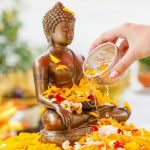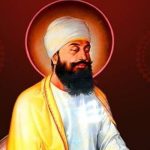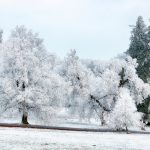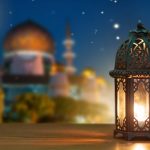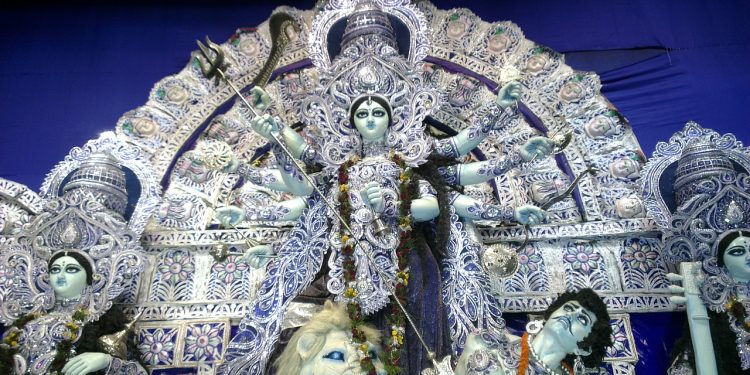
Navaratri
“`html
Navaratri is a Hindu holiday that occurs over a nine-day period in either September or October on the Gregorian calendar. This holiday is observed throughout India and commemorates the slaying of the demon Mahishasura by the goddess Durga, a battle that lasted nine days and nights. However, in some parts of India, this period is also used to commemorate all female deities. At its essence, Navaratri celebrates the triumph of good over evil and is a way to give thanks for a good harvest. While it is celebrated in different ways around the world, most celebrations feature colorful clothing and fasting followed by elaborate feasts. On the Hindu calendar, Navaratri begins on Ashvin Shukla Prathama and ends on Ashvin Shukla Navami.
History of Navaratri
In different parts of India, various legends account for the history of the festival of Navaratri. In Northern India, there is one legend, in Eastern India a completely separate legend, and yet another one for the rest of India. However, while these stories seem to be different, they are all interconnected, complement each other, and represent different aspects of the holiday.
Eastern India
According to the story, as told in Eastern India, it all begins with Daksha, the king of the Himalayas. This king had a very beautiful and virtuous daughter whom he named Uma. She had been a devout follower of Lord Shiva her entire life and wanted nothing more than to marry him. She worshiped him devoutly and eventually, he called on her to marry him. However, this displeased her father Daksha, so he ended his relationship with his daughter and her husband, Lord Shiva.
Eventually, Daksha organized a ritual offering known as a yagna but did not invite Lord Shiva to it. Uma became so angry at her father’s rudeness towards her husband that she decided to take her own life by jumping into the yagna’s fire pit (known as an agnikund). In the agnikund, she was united with eternity and later became reborn to once again win her husband, Lord Shiva’s hand. Ever since then, according to legend, Uma returns every year with Ganesh, Kartik, Saraswati, and Lakshmi to her parents’ home during this holiday.
Northern India
In Northern India, the story begins with a demon called Mahishasura. This demon worshiped Lord Shiva until he was granted the power of eternity. After obtaining this massive power, he began to harass and kill innocent people all over India and also set out to conquer the three Lokas: Urdhva Loka (the heavens), Madhya Loka (earth), and Adho Loka (the underworld). Eventually, the gods of Swargaloka pleaded with Lord Shiva to give them a way to dispose of the demon. The Trinity of Brahma, Shiva, and Vishnu united all their powers and created Goddess Durga, a divine female warrior. She then set out to defeat the demon.
When Mahishasura laid eyes upon Goddess Durga, he was instantly mesmerized and fell in love with her. He approached her for her hand in marriage. Goddess Durga accepted his proposal but gave him one condition: he would have to defeat her in battle. He agreed, and for the next nine days and nights, they battled. Eventually, she defeated and beheaded the demon. Ever since then, the nine nights have been known as Navaratri. The day following this holiday, the tenth day, then became known as Vijayadashami and is a celebration of the triumph of good over the forces of evil.
Other Parts of India
In yet another story, Lord Rama is said to have worshiped the Goddess Durga for nine days to gain the strength to kill Ravana, the demon king of Lanka. Lord Rama wanted to rescue Sita, the daughter of King Janaka of Videha, who had been kidnapped by Ravana, and free her from his clutches. Those nine nights he worshiped Goddess Durga later became known as Navratri. The day following these nine days, the tenth day, was when Lord Rama slew Ravana, and this day became known as Dussehra. As with the other legends, the tenth day represents the triumph of good over evil.
Navaratri Customs & Traditions
As is the case with the stories behind Navratri, the holiday is celebrated in different ways by different people in different regions. In Bengal, there are usually parades featuring large idols, and these parades can be quite elaborate and very colorful. In some parts of India, earthen pots are painted and filled with either water or a lamp, symbolizing the power of Goddess Durga. In other parts, plates are decorated in honor of the mother goddess. This period is seen as one of great auspiciousness, which is why many women buy new clothes, jewelry, and kitchenware. In most areas of the country, women wear their most colorful clothing throughout the nine days.
Fasting is also observed during this time. While some people will not eat any food whatsoever during parts of Navaratri, others will simply abstain from certain foods. The foods which are abstained from usually include corn, cornstarch, onions, garlic, lentils, legumes, rice, alcohol, coffee, and refined oils. However, this is not a comprehensive list, and some practitioners will abstain from other types of food as well during this nine-day holiday period.
Often during this holiday, there will be many celebratory meals which include dishes such as Kuttu Ka Dosa, Singhare ke Atte ka Samosa, Banana Walnut Lassi, Sabudana Khichdi, Aloo ki Kadhi, Arbi Kofta with Mint Yogurt Dip, Kebab-e-Kela, Sonth ki Chutney, and Samvat-Pulao.
“`
